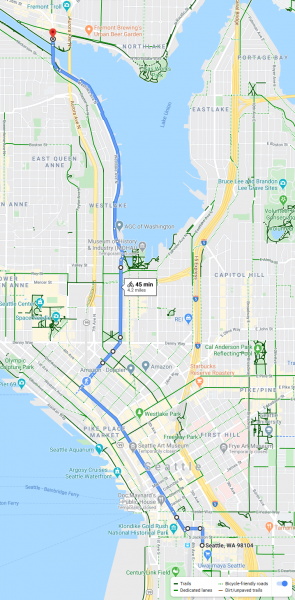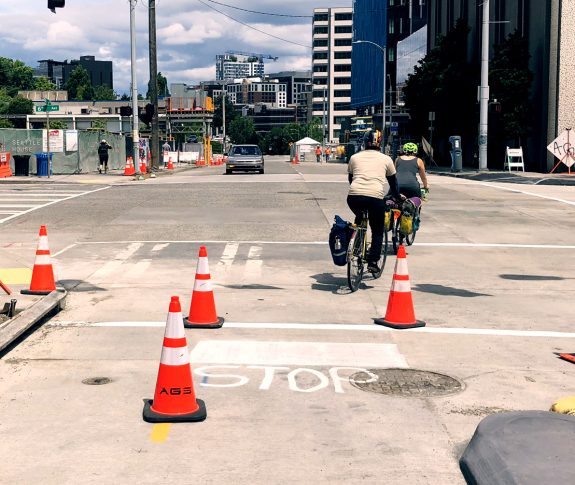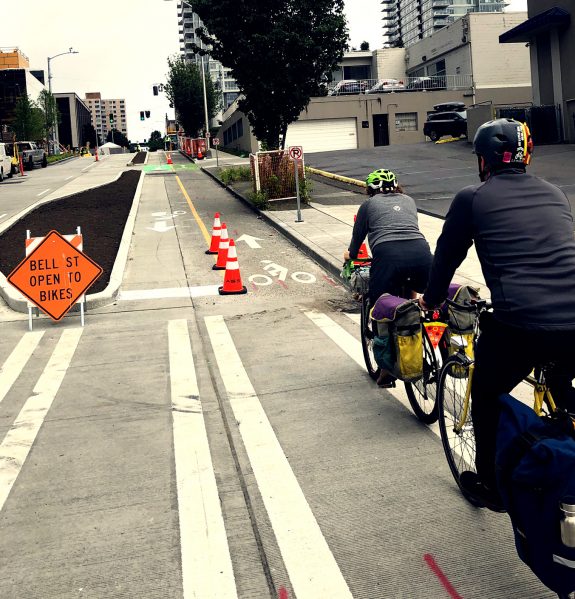
Seattle is only one block away from completing a connected bike route through downtown from the International District to Fremont and the Burke-Gilman Trail.
This project has been the result of so much work by so many people (too many to name, but obviously Cascade Bicycle Club, Seattle Neighborhood Greenways and individual advocates like so many of you). Years and years of advocacy and passing funding measures have led to this point. Sure, it’s taken a lot longer than originally hoped, and sure there will still be some incomplete details due to budget cuts and construction zones. But it’s almost finally here.
The key to connecting the 2nd Ave bike lane to the temporary 9th Ave bike lanes is making Bell Street a two-way street for people biking. For years, people have had to bike in mixed traffic on Blanchard Street, but not any more. By designating Bell Street Park a “Stay Healthy Street” between 1st and 5th Avenues, car traffic has been limited and people can bike both directions.
Meanwhile, SDOT crews have poured curbs to create a two-way bike lane on the north side of the street from 5th to 6th and 7th to Denny/9th. That leaves only the single block between 6th and 7th Avenues missing from a complete bike route that seemed like a dream a decade ago when I started writing Seattle Bike Blog.

SDOT says they will install a temporary bike lane in that block as early as next week, and the construction project across the street will be responsible for building the final version. It may also take a couple more weeks to get the temporary traffic signals functioning (until then, people biking should follow the walk signals). And budget cuts may impact delivery of the permanent traffic signals.
But give SDOT credit here, they are making this connection happen with what they’ve got to work with. Hand-drawn bike lane symbols have become a meme, and I just want to say I love them. Mayor Durkan has pulled the bike budget in response to COVID-19 budget shortfalls, but SDOT crews are going to finish this one bike route dammit. They will paint this shit by hand if they have to. So, bike lane artist and everyone at SDOT who has worked so hard to make this happen, thank you.
SDOT doing some freestyle bike markings on Bell Street. pic.twitter.com/p3kqq2eTjn
— Qagggy! (@Qagggy) June 29, 2020
Though the COVID-19 crisis will prevent the city from having the proper community celebration this bike route completion deserves, Seattle Bike Blog would like to thank everyone who has dedicated time and energy pushing for what once seemed impossible. The work to create a bike network that reaches everyone’s homes and destinations is far, far from over, but this route is a strong backbone.









Comments
15 responses to “With just one block missing from the Bell Street bike lane, Seattle’s ID-to-Fremont bike route is nearly complete”
This is good. Too bad the route uses the sucky compromise Westlake trail. Maybe enough bike traffic will develop that the businesses will reconsider their parking anxiety and allow a proper trail to be built through the parking lot alongside the road.
I’m super curious what will happen when 10,000-20,000 people a day try to bike on this route at 12-14 mph — designed and built at great cost for a fraction of that volume at 10 mph.
It seems unlikely, though, that many of us will be returning to Downtown until 2021 at the earliest.
When that happens, I’ll rejoice ! That kind of demand will justify substantially more investment in our bike infrastructure.
Mayor Jenny Durkan is undoubtedly salivating wolf-like at the thought of devouring these bike lanes to push a few more cars through downtown, as soon as the pandemic is over. Don’t worry though, I’m sure she will be dissuaded by the bleating from the the bike lobby.
A huge thanks to SNG, Cascade, and staff and crews at SDOT, especially Sam Woods for her tireless dedication to the details- I hope she gets to be one of the first to ride the full route when it’s in place.
You say it “…seemed like a dream a decade ago when I started writing Seattle Bike Blog.”
John Lennon said, “A dream you dream alone is only a dream. A dream you dream together is reality.”
Thank you for your big part in this, helping us dream together.
The pandemic has definitely accentuated my awareness of the scarcity of all-ages bike infrastructure around Seattle.
With my opting out of public transit (too many people without masks, no enforcement even on Link), biking would be super handy.
But only a tiny fraction of trips have any infrastructure, almost 5 years into Move Seattle (and all the decades of tax money spent beforehand).
Eli, which decades are you referring to? 1890’s-1920’s? Hardly a dime between then and 2015.
Hey Don, as you know, we had a bike plan and gobs of money spent on bike infrastructure prior to 2016.
e.g. https://www.seattlebikeblog.com/wp-content/uploads/2016/10/image2.png
This looks like around $20 million dollars just from 2009-2014, but I’m eyeballing.
Eli, The 2007 Seattle Bicycle Master Plan contained some good thought and planning, but implementation went mostly for wayfinding signs, bike parking racks, modest trail improvements, and white paint to mark sharrows, door zone bike lanes and climbing lanes. Not really “gobs of money”.
https://nacto.org/references/seattle-bicycle-master-plan-2007/
The 2014 BMP was the first to plan a real network of all-ages-and-abilities routes with substantial projects including protected bike lanes and bridge projects. Money for the 2014 BMP did not start flowing until 2015, with slow ramp up into 2016. The “Citywide” network under the 2014 plan is scheduled to be built out by 2030. If it were going according to plan, those higher priority routes would be at about half complete by now. The remainder of the mapped network is scheduled to be completed by 2035. The city is behind on both targets, due to slow ramp up and due to the current administration putting on the brakes for political reasons in 2019.
My recollection was that, even pre-Move Seattle, PBOT staff I met appeared to be envious of the size of the bike budget we had here in Seattle (vs. the shoestrings that they delivered much higher ridership outcomes with, through opting for AAA infrastructure over the 3%-er infrastructure we built).
Having read (and critiqued) the 2007 bike plan back in the day, I personally feel it was largely obsolete upon completion. Its fatal flaw was in being designed for a “biking is for cyclists” / “designing for risk-seeking athletes” worldview that Cascade was still actively promulgating, which other North American cities had already pivoted away from.
This lost decade is arguably why Vancouver and Portland have built-out and connected networks of all ages infrastructure, and we don’t. I don’t know Vancouver’s budget, but I’ll bet money that we spent a lot more than Portland did.
Also, I freely concede that it’s all kinda moot now — other my frustration at the limited mobility resulting from a prior generation of bad choices (now that Americans are all now living inside Trump’s wall.)
Eli, It’s really hard to compare cities’ budgets, because they account for costs so differently.
However, Portland spent $134M on one bike bridge. That one project is many years of Seattle’s spending on it’s whole network of bike projects. Seattle has not invested enough to get to its goals.
Actually, just for the record, I believe Tri-Met spent $134 million on a light rail bridge located in Portland that has includes a (relatively narrow) protected bike lane alongside its primary function — moving public transit vehicles.
This is actually a useful route. It connects a number of neighborhoods and does so in as straight-lined as possible. No dog legs, no stupid jogs from one side of the street to the other. No confusing gaps. Excellent !
In May I started bike commuting between Ravenna and West Seattle. I love the changes made on Bell Street and thank everyone who put time into this. And I too sort of miss the quirky freehand cyclist figures. Something sort of entertaining and sort of annoying- both motorists and cyclists have informed me that I’m going the wrong way on Bell Street. An arrow or two might clarify that for everyone.